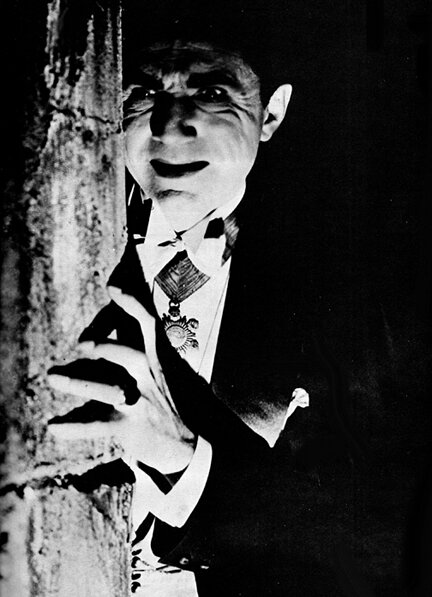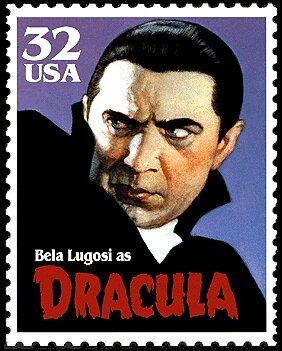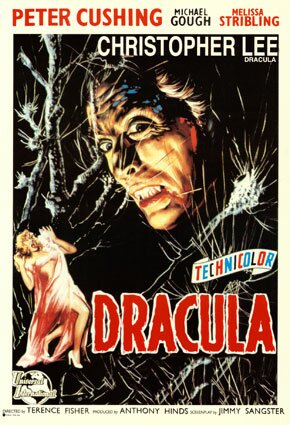Dracula
 Bela Lugosi as Count Dracula
Bela Lugosi as Count Dracula
Do Not Be Afraid...
How One Dead Actor Successfully Sued Hollywood
By TOM SOTER
from COLUMBIA DAILY SPECTATOR, October 31, 1977
What do Bela Lugosi, U.S. District Court 374, Bram Stoker, Universal Pictures and Halloween all have in common?
The answer: Dracula or more particularly, the Dracula Halloween costumes that were an important element in determining a person's "right of publicity."
Yes, you read that right. It's not widely known, but in addition to privacy rights, people can also have publicity rights. So, what's the difference and how does Dracula fit in?
To answer the first question first, the court has said that a person has the "right to be protected against the use of his face for commercial purposes." But it has also ruled that such a right ends with death, since privacy isa state of mind-a desire to be free from "excessive publcity" and cannot be '''invaded'' when the mind is no longer functioning. The Young family, therefore, could not collect for this true statement made on a satirical TV show: "Mrs. Katherine Young of Syracuse, N.Y., who died at 99 leaving five sons, five daughters, 67 grandchildren, 72 great-grandchildren, and 73 great-great grandchildren gets our First Annual Booby Prize in the Birth Control Sweepstakes." The, deceased, Mrs. Young's privacy could hardly be disturbed and consequently her children had no case.
'
The right to privacy is also compromised when a person. becomes a public figure. The generally agreed upon princ'iple is that once you are a celebrity you have surrendered a great deal of your privacy. You have entered the public eye and should expect. public scrutiny-whether you're an author, a sports figure or a politician. The public has a legitimate interest in' what you 1:lo and news sources should not be punished for responsibly contributing to the market-place of ideas
Thr rightto invade a person's privacy is not unlimited, however. The Court has stated that "A celebrity has a legitimate property interest in his public personality." The main question in all public figure decisions, then, is: "was the story exploitation or news?"
With this in mind Universal Pictures, which was responsible for .BelaLugosi's two appearances as Bram Stoker's Count Dracula in Dracula (1931) and Abbott and Costello Meet Frankenstein (1948), felt it wasn't treading on anyone's toes when they leased the late actor's face to a Halloween mask company in the early 1960's. The psuedo-Count's son, Bela George Lugosi, felt otherwise, however. In a 1972 case, he insisted that the movie studio had no business using his father's likeness without reimbursing the Lugosi family.
Universal's lawyers quickly cited the privacy rulings and argued that even if they didn't apply, the fact that Lugosi had signed a contract with Universal meant that he had given up certain privacy rights. Being dead' and under contract locked up ,.the matter, the studios asserted, saying the Lugosis couldn't collect.
 Lugosi as stamp: exploited - again!
Lugosi as stamp: exploited - again!
The court disagreed. Dealing with the last point first, Judge Bernard S. Jefferson commented that Lugosi's contract did indeed allow Universal to' "use and exploit any and all of the artist's acts, exposes, plays and appearances in connection with the, advertising and exploitation" of the films. But, he added, "The products such as kites and shirts which were licensed to carry the appearance of. the Count Dracula character were not sold at all in connection with any advertising of the Dracula photoplay to appear on television or any theatre screen," and therefore, the contract did not apply.
'
Dealing next with the more important question of privacy, Judge Jefferson reason that since public figures have a lesser right to privacy than others do, they also have greater publicity value. Consequently, even though Lugosi had no privacy standing any longer, his face was still a marketable property.
The importance of this point becomes clear when' one realizes that property rights, unlike privacy rights, have a pesuniary value and are therefore transferable to heirs. The argument goes that since privacy is a mental condition, and publicity a monetary one,' heirs should be able to collect whenexploitation Occurs. Although Lugosi was dead, his publicity value was still intact as a property right and could be transferred. Universal therefore, owed the Lugosi family an apology, and quite a' bit of money as well, since it had exploited the actor without permission. In so doing, however, it set an impOrtant legal precedent, and also proved that you can't keep a good vampire down-even when he's really dead.
He Haunts the Screen
Although many actors have essayed the role of Bram Stoker's Count Dracula, it is Bela Lugosi with whom the role is popularly associated. The curious thing about this is that Lugosi, unlike a later Dracula, Christopher Lee, appeared in only two films as the Transylvanian count.
 Hammer Films revived Dracula.
Hammer Films revived Dracula.
The first of course, was Dracula (1931), directed by Tod Browning (who was later to do Freaks, a movie about mutants that. was banned when released in 1933) for Universal Pictures, and co-starring Dwight Frye and Edward Van Sloan. It was', based on a successful Broadway play in which Lugosi had starred and was photographed by the talented Karl Freund, who had worked on F.W. Murnau's Last Laugh (1924) and Fritz Lang's Metropolis (}927) before coming to Hollywood where he photographed The Mummy (1932); Camille (1936),and Key Largo (1948), among others.
Lugosi's subsequent vampire films were hardly as noteworthy. Following the success of Dracula the Hungarian born actor teamed up with Browning again for 1935's Mark of the Vampire (1935), as an anonymous blood-sucker with a daughter (Carol Borland), pitted against Lionel Barrymore. In Devil Bat (1940), Lugosi was a mad scientist attacked by his own vampire bats; and in The Return of the Vampire (1943) he played Armand Tesla, "a notorious Rumanian vampire" who runs amok in World War II London.
The actor made his final appearnace as' Count Dracula in the horror movie sendup Abbott and Costello' Meet Frankenstein (1948), which also co-starred Lon Chaney Jr. as the Wolf Man and Glenn Strange as Frankenstein's monster. Needless to say, it was a sorry end for, an illustrious creation, but the worst wa/; to come, as Lugosi'sfinal vampire film was the insipid Mother Riley Meets the Vampire (1952). He died in 1956 at age 74 in a state institution for the drugaddicted and the poor.
Other actors who appeared as Dracula over the years are Max Schreck, Lon Chaney (both Sr. and Jr.), John Carradine, Francis Lederer and, most notably, Christopher Lee, who has built his career on his many appearances as the Count.